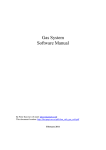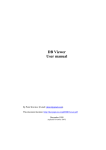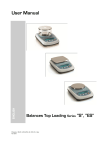Download DBViewer User Manual
Transcript
DBViewer User Manual Peter Kravtsov (E-mail: [email protected]) Document location: http://lkst.pnpi.nw.ru/pdf/DBViewer2en.pdf. 2009 DBViewer: User Manual Table of contents Table of contents........................................................................................................2 1 Introduction ......................................................................................................3 2 Main software features ......................................................................................4 2.1 Parameters selection ...................................................................................4 2.2 System message log ....................................................................................5 2.3 Chart...........................................................................................................6 2.3.1 Time range selection (Filter) ...............................................................6 2.3.2 Chart legend and axes .........................................................................8 2.3.3 Scroll and zoom ................................................................................10 2.3.4 Chart context menu ...........................................................................11 2.3.5 Cursor ...............................................................................................13 2.3.6 Data grouping ...................................................................................13 2.4 Status bar of the main window ..................................................................14 3 Data export .....................................................................................................14 4 Additional features of the software..................................................................16 4.1 Database merge ........................................................................................16 4.2 Data removal ............................................................................................16 4.3 Database compact .....................................................................................16 4.4 Extend ControlData timescale feature .......................................................17 4.5 Data retrieval interrupt ..............................................................................17 4.6 Chart editor...............................................................................................18 4.7 Additional options and menu items ...........................................................19 Page 2 of 20 DBViewer: User Manual 1 Introduction DBViewer program is a dedicated software that provides comprehensive facilities for the slow control data visualization and analysis. The software includes friendly Graphical User Interface and allows graphical representation of the slow control parameters in the form of time charts (up to four charts simultaneously), and export of the time history for selected parameters to the text or MS Excel format. Both visualization and data export could be filtered and averaged by time limits. Fig. 1. DBViewer main window. The DBViewer software utilizes multithread database access, which speeds up the data retrieval from the database and user action response. All data retrieval from the database is implemented in background, both for the charts and export functions. Page 3 of 20 DBViewer: User Manual 2 Main software features The main window of the software (Fig. 1) is split into three functional zones: • Time dependence charts (central part of the window); • System parameters tree (left side of the window); • System messages log (bottom of the window). Main window contains also a menu and toolbars, which duplicate the main menu actions. Some controls are also equipped with context menu. All these elements are described below. During the database open procedure (File/Open menu or toolbar button, [Ctrl-O]) the software reads the parameters list of the system under control, grouped by categories, and the system messages log. All available parameters are shown in the tree view with possibility to select up to four parameters for the chart display, and a set of parameters for the export. 2.1 Parameters selection Tree view of the system parameters (Fig. 1) displays all available process variables grouped by categories. Four radio boxes located on the right of the parameter name correspond to four lines in the chart. All charts have the same time scale, which provides analysis of the synchronous parameters behavior. User can select only one chart for the single parameter. By clicking on the radio box and selection of the parameter the data retrieval process begins. The process of the data transfer from the database to the chart is shown by a percentage progress indicator in the chart legend, for every particular parameter. Fifth switch – a check box next to the parameter name in the tree view – is used for the export function. The number of parameters in the export function is unlimited. The tree view allows multiple selection of the parameters (Fig. 2) using dragging by mouse with holding left button, or using Shift or Ctrl buttons at the keyboard. Set or clear the check box for the export for any selected parameter will check or clear all selected set of parameters. Page 4 of 20 DBViewer: User Manual Fig. 2. Selection of the parameters set for the export. Parameters tree view could be switched off with menu View/Channel tree or toolbar button: . Display of the disabled parameters (a special category which of parameters that are not used in the control software) is controlled by a menu item View/Disabled channels or toolbar button . One can clear the export list of the parameters and all the checkboxes using menu item Export/Clear all checkboxes. 2.2 System message log System message log contains all the messages written into the database by control software. Depending on the control software used, these messages can include error messages, status messages, and alarm messages as well. Every message in the log window (Fig. 3) is shown with color and icon corresponding to the message type, and supplemented with the time stamp of the message. Fig. 3. Message log of the CHUPS system. Page 5 of 20 DBViewer: User Manual In addition, there is a special column with checkboxes in the right side of the message log window. Checked messages are displayed in the chart with vertical dot line (Fig. 1). If cursor information is enabled (Chart/Show cursor information menu item or toolbar button), message is also displayed in the cursor information when it is located near the corresponding time (see example in Fig. 1). Message log window can be switched off using View/Log window menu item or toolbar button. 2.3 Chart Time dependence chart for the system parameters is the main goal of the DBViewer software, and the most of the controls are concentrated in the chart, correspondingly. 2.3.1 Time range selection (Filter) Time filter of the chart provides display of necessary data ignoring the whole history of the parameters behavior. This is very important for the large databases, where the number of records can achieve few millions. It is ridiculous to display all data points in a single chart in this case. There are two time filter modes in the software: the first one supposes direct editing of the filter values; the second mode uses a special navigator toolbar, which allows paging the chart timescale by fixed time period. One can switch the time filter mode using the menu item Options/Use navigation panel (Use Date/Time Filter) or the toolbar button / . The navigator is implemented for the compatibility with old versions of the software, where it was the main time range control. It is recommended to use direct time filter editing. 2.3.1.1 Time filter navigator In navigator mode (Fig. 4), user can select starting time and period, which could be an hour, a day, a week and a month. Time period defines the scale of the time axis. Then the navigator buttons could be Page 6 of 20 DBViewer: User Manual used for paging the chart by specified period. The buttons of the time filter navigator (Fig. 4, left to right) are: • Beginning of the database; • Previous time period; • Next time period; • Last time period of the database; • Apply current settings of the time filter. Fig. 4. Time filter navigator. Time filter navigator requires time limits of the whole database to be read from the database. This could be done using the menu item File/Read time limits or the toolbar button . Time limits read from the database are shown in the main window caption and indicated in the status bar. 2.3.1.2 Direct time filter editing Time filter bounds could be directly edited in the toolbar using the special editor (Fig. 5). One can specify the time filter starting time in the left part of the toolbar and the end time in the right side. Two checkboxes are used to enable both time limits separately. Fig. 5. Direct editor of the time filter. Such editor layout becomes useful for the working with the database, which is still in use by the control software. Since the database is permanently updated and new records are added, one can enable the left part of the time filter and disable the right side. Then the button will retrieve the last records from the database. If the time limits of the entire database are read (see section 2.3.1.1), the software checks the time filter bounds to be inside the database time limits and corrects them if necessary. Page 7 of 20 DBViewer: User Manual Fig. 6. Time filter editing using the chart context menu. Usually it is more convenient to specify the time filter bounds directly on the chart. This could be done easily using the context menu of the chart (Fig. 6). User can select left or right bound in the menu (Set left bound and Set right bound items, correspondingly). One can also use [<] and [>] keys of the keyboard with the same result. Time filter bound is taken from the current time position of the cursor at the chart, and appropriate side of the filter is automatically enabled. The retrieves the records from the database using the time filter. The same could be done through the context menu or pressing the [SPACEBAR] at the keyboard. Selection of the new parameter in the parameter tree will also take into account time filter bounds. New parameter values will be read only for the specified time period. In contrast to Apply Filter button, Chart/Refresh data menu item or toolbar button switch off both time filter sides and retrieve all records from the database. 2.3.2 Chart legend and axes The chart displays a time dependence of some (up to four) system parameters. Parameter name and measurement units are shown in the chart legend. Name color in the legend corresponds to the chart line color. The Page 8 of 20 DBViewer: User Manual checkbox next to the parameter name is intended for enable/disable this parameter chart (Fig. 7). Fig. 7. Multiple vertical axes. All system parameters are shown using the single time axis which is automatically scaled. Vertical scale could be changed for each parameter. One can enable multiple vertical axes mode for the chart using Chart/Multiple Y axes menu item or toolbar button . In this mode separate vertical axis is displayed in the chart for every system parameter (Fig. 7). In the single Y axis mode, all parameters are shown with the single vertical axis. If multiple vertical axes mode is disabled, all system parameters are displayed with single left vertical axis by default. But there is a feature to assign some parameters to the second, right vertical axis. Using the context menu in the chart legend (Fig. 8) user can select left or right axis for each particular parameter, which was pointed by a mouse cursor. System parameters assigned to the vertical axis are indicated by short lines of appropriate color above the axes. Page 9 of 20 DBViewer: User Manual Fig. 8. Two vertical axes and context menu of the chart legend. There are many additional features for fine customizing of the chart axes, which are available to the user through the chart editor (see section 4.6). 2.3.3 Scroll and zoom Zoom feature allows magnifying a small part of the chart for detailed analysis. There are many ways to zoom the chart. User can magnify, reduce the chart or reset the original zoom factor using menu items Chart/Zoom in, Zoom out, Unzoom, correspondingly. The same actions could be done using the toolbar buttons: or using keyboard [F2, F3, F4]. The chart could zoomed using the mouse wheel. Double click on the left mouse button resets the zoom factor to the original scale. Fig. 9. Selection of the zoom area. In addition, user can select a particular area of the chart to zoom it in, using the left mouse drag (Error! Reference source not found.). By release of the left mouse button selected area will be magnified to the Page 10 of 20 DBViewer: User Manual whole chart, if it was selected from left to right. Reverse selection (from bottom-right corner to top-left) resets the chart to the original zoom. One can also scroll the chart using the dragging with the right mouse button. Again, double click on the left mouse button or reverse zoom dragging or toolbar button will reset scrolled chart to the original scale. 2.3.4 Chart context menu The chart context menu (Fig. 10) was already mentioned in section 2.3.1.2 with regard to direct editing of the time filter bounds on the chart. In addition to time filter bound selection, this menu duplicates also buttons and (Chart/Refresh data), which could be executed also with keyboard buttons [Spacebar] and [R]. Next menu items group duplicates the main menu Chart and is used for the exporting and printing of the chart picture. The image of the chart could be written in PNG format (Export to PNG menu item or [Ctrl-G]), and in BMP, WMF, PDF formats using the export dialog of the chart editor (Export chart menu item or [Ctrl-S]). The same export dialog could be used to save the chart data in the various text formats (Fig. 11). It is recommended to use export function of the DBViewer software to export of large amount of data, or more than four system parameters (see section 3). Page 11 of 20 DBViewer: User Manual Fig. 10. The chart context menu. Fig. 11. The chart data export dialog. The chart image could be printed using the Print chart menu item (available through the chart context menu or main menu File and Chart, and with the keyboard [Ctrl-P]). This action opens Print preview dialog with print settings. Submenu Y axis format shown in Fig. 10 is duplicated in the main menu (Chart/Y axis format), and serves for the changing of the label format of the vertical axes. User can select one of the predefined formats, which will be set for all vertical axes. This could also be done through the chart editor for every axis separately. This submenu provides fast changing of the label format, which sometimes is very convenient for switching between exponential and decimal formats. Page 12 of 20 DBViewer: User Manual The last menu item of the chart context menu (Chart editor) is also duplicated in the main menu Chart and [E] keyboard, and is used to show the chart editor that is briefly described in section 4.6. 2.3.5 Cursor The mouse cursor in the chart can be used to read the data from the chart and to indicate the system messages. It is can be enabled or disabled using Chart/Show cursor information menu item or toolbar button . The chart is shown with vertical and horizontal yellow lines. Current time and vertical axis values are displayed near the cross of the cursor. In the multiple vertical axes mode (section 2.3.2) only first (right) vertical axis value is displayed. 2.3.6 Data grouping The grouping of data is powerful feature for reducing the data amount shown in the chart. With disabled grouping software reads all records from the database according to the time filter and shows all data in the chart. This means that DBViewer will read all selected parameter values from the database if time filter is disabled, for instance, after menu item Chart/Refresh data, or toolbar button or keyboard [R]. The number of records can exceed some millions. This will lead to huge memory consumption and long data retrieval time (for average PC retrieval of 1 million data records and transfer them to the chart memory requires about 80-90 seconds). Grouping of data allows speeding up the retrieval of large amount of data and essentially decreasing the number of data points. For example, grouping by minutes decreases data retrieval time 2-3 times for the mentioned database, and also reduces the number of points from 1 million to 32 thousands. Grouping by hours decreases data retrieval time to 10 seconds and records number to 540. Data grouping can be changed using menu items Options/No grouping, Group records by minute, Group records by hour, or by toolbar switch . If grouping is used, the system parameters Page 13 of 20 DBViewer: User Manual values are averaged by a specified time period (minute or hour) and are presented by a single point at the chart. Switching of the grouping type does not affect the data shown in the chart, but affects all further data retrieval. Since the parameter values are averaged with data grouping, the time dependence of the system parameter is slightly smoothed. But, in most cases, averaged data is enough to estimate the system parameter behavior. It is also useful to select time filter bounds using the averaged chart and then retrieve the data without grouping for the required time period. Grouping mode is indicated in the status bar of the DBViewer software. 2.4 Status bar of the main window The status bar of the main window displays current state of the program and some additional information about modes in use and last database operation (Fig. 12). Left part of the status bar contains additional description of the system parameter name. Next sections of the status bar show the following information: o RO - Read-Only database in use, o TL - indicates that time limits are read from the database, o E:NOGRP - grouping mode for the data export (NOGRP, MIN, HOUR), o C: MIN - grouping mode for the chart (NOGRP, MIN, HOUR), o Query: 610ms - execution time of the last database query, o Chart: 62ms - data transfer time from the database query to the chart, o Records: 720 - records number in the last database query. Fig. 12. Status bar of the DBViewer software. 3 Data export The data export function provides writing of values for all selected system parameters, which comply with the time filter conditions, into text file or MS Excel file for further analysis. System parameters can be selected for the export using right column with checkboxes in the Page 14 of 20 DBViewer: User Manual parameters tree view (this was described in section 2.1). If no parameters are selected for the export, this function is disabled. Text file export can be started using menu item Export/Export to TXT-file, or using toolbar button or [Ctrl-T]. MS Excel export is executed using menu item Export/Export to XLS-file, toolbar button or [Ctrl-E]. Both export functions request file name to write data values to and executes a special database query afterwards. Export function is working in background, so user can operate the DBViewer software as usual and show system parameters in the chart. Execution of the export function is indicated by blinking export column header in the parameters tree view (Fig. 13). By completion of the export procedure, program notifies user with a message window. Fig. 13. Data export indication. Since the system parameter values in the database are located in three tables with separate time scale in each table, parameters from different tables are not combined during the export procedure. Instead, they are written into different tables of the output file. Thus, during the data export into the text file filename.txt the software will create, depending on selected parameters, up to three different files with names filename_Fast.txt, filename_Slow.txt and filename_Control.txt. In the same way, MS Excel export procedure creates up to three worksheets named Fast, Slow and Control. The number of rows in MS Excel format is restricted (65535), therefore the software suggest user to apply data grouping if exported records number exceeded this limit. Data grouping, the same as with chart data retrieval, allows significantly decrease the amount of data processed by averaging the values over the grouping period (minute or hour). Data grouping for the export can be selected using menu items Export/No grouping, Group records by minute, Group records by hour. System parameter values Page 15 of 20 DBViewer: User Manual are averaged over grouping period, if data grouping is used, and are written in the export file in a single table line. 4 Additional features of the software 4.1 Database merge The DBViewer software can be used for the merging of the databases. The data records can be appended to the currently open database from another database using menu item File/Append data from… or toolbar button . By this action current database will be supplemented with all parameter data records from the second database, and system message log will be added as well. Other tables, including parameter names, will be kept without changes. The software will display message box by completion of this operation. 4.2 Data removal The data removal function is implemented in the software for the experienced users. It can be executed through the pull-down menu at the right side of the [Apply Filter] button in the time filter toolbox (Fig. 14). The software will ask for the confirmation before data removal. Fig. 14. Records removal from the database. Attention! The data removal procedure deletes all parameters data for all tables, according to the time filter bounds. This means, that it will erase all data if the time filter is switched off. Data records recovery is impossible! 4.3 Database compact During the data history accumulation the file size of the database is increased by MS Access DBMS engine not proportional to the data records appended. The file size increases much faster for the space reservation for database operations, especially during the simultaneous Page 16 of 20 DBViewer: User Manual access to the database from the control software that writes the data and from the DBViewer software that reads the data from the database. If only reader has access to the database (for example, using DBViewer for finished and archived database), the file size does not change. The database compact function serves for the decreasing the database file size without changing the data inside. This procedure works only with exclusive access to the database and could not be executed for the database, which is still in use in the control software, or the database file has read-only attribute. The database compact function can be executed using menu item File/Compact database or toolbar button . 4.4 Extend ControlData timescale feature The ControlData table is intended to keep the control parameters data, which are changed by the user. This means, that this table is appended in the control software not regularly but only after some user actions. Therefore the time scale of the control data can differ dramatically from the other parameters tables. If it does differ, the control parameter line in the chart can start later than normal parameters and finish before the others. This imperfection could be corrected in the DBViewer software by a special function, which is called through the File/Extend control timescale menu item or toolbar button. This procedure adds two records to the ControlData table. First record contains all parameter data from the record with minimal time. The time value of this record is equal to the minimal time of the FastData table. Second record contains the latest ControlData record values with the maximum time of FastData table records. Thus the timescale of the ControlData table is extended to the entire database time scale, with the parameters data left intact. 4.5 Data retrieval interrupt There is special button in the top-right corner of the chart, which appears during the data retrieval process. The software stops the Page 17 of 20 DBViewer: User Manual data transfer from the database query to the chart by this button. Data retrieval from the database could not be stopped gracefully. 4.6 Chart editor It was already mentioned in section 2.3.4 that chart editor can be shown using the Chart editor menu item in the chart context menu, which is duplicated in the main menu Chart, and keyobard [E]. The chart editor (Fig. 15) provide fine adjustments of the chart itself (Chart tab), color and style of the chart lines (Series), and many other properties of the chart. Fig. 15. The chart editor. Series list. Due to huge number of the chart features it is useless to list them here, especially as they are described in the chart editor help. The help system is context sensitive. One can use question mark in the caption of the chart editor window and then click on the editor control to get information about this control (Fig. 15). Page 18 of 20 DBViewer: User Manual Fig. 16. The chart editor. Axis labels format. The color of the chart lines can be changed by double click on the line section in the series list. The chart panel background color and bounds are edited in the Panel tab. Titles of the chart – in the Titles tab. Axes scales, position, titles, ticks and labels format – in the Axis tab (Fig. 16). The chart editor is equipped with the export tools for writing the chart picture in various formats (Export tab) and for printing as well (Print tab). 4.7 Additional options and menu items Menu File contains the list of recently used databases. The same list is displayed in the drop-down menu next to the open database toobar button (Fig. 17). This list contains up to six recently used file names and can be used to open them again. Page 19 of 20 DBViewer: User Manual Fig. 17. Recently used files list. In addition, Options/Automatic load last used menu item can be use for the automatic load of the last used database at the program startup. Options/Large icons in toolbars menu option serves for the switching of the toolbar buttons size (Fig. 18). Fig. 18. Toolbar icon size switch. Options/Use array data transfer option is used to select the algorithm of data transfer between the database query and the chart. Array data transfer usually speeds up the data transfer for large amount of data, but slow down the query execution time. The total time of query execution and displaying the parameter history at the chart decreases in this mode. Old algorithm is kept for compatibility issues and is executed if this option is disabled. Page 20 of 20






























